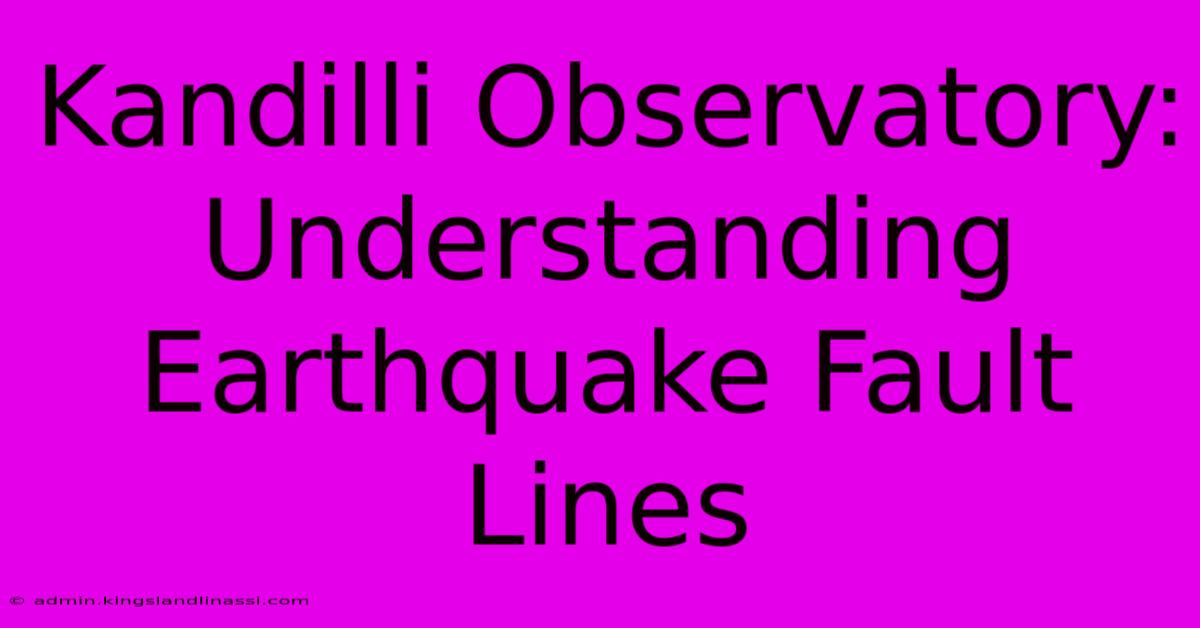Kandilli Observatory: Understanding Earthquake Fault Lines

Table of Contents
Kandilli Observatory: Understanding Earthquake Fault Lines
The Earth beneath our feet is a dynamic, ever-shifting landscape. Understanding its movements, particularly those that lead to devastating earthquakes, is crucial for mitigating risk and building safer communities. At the forefront of this vital work stands the Kandilli Observatory and Earthquake Research Institute (KOERI) in Istanbul, Turkey. For over a century, Kandilli Observatory has played a pivotal role in monitoring seismic activity, researching earthquake fault lines, and enhancing our understanding of these powerful geological events.
The Importance of Earthquake Monitoring
Earthquakes are a significant hazard, particularly in seismically active regions like Turkey, which sits at the intersection of several major tectonic plates. The Eurasian, African, and Arabian plates collide and interact in this region, creating a complex network of fault lines. These fault lines are fractures in the Earth's crust where tectonic plates meet, and their movement is the primary cause of earthquakes.
Accurate and timely earthquake monitoring is critical for several reasons:
- Early Warning Systems: Observatories like Kandilli provide data that feeds into early warning systems, giving communities precious seconds or minutes to prepare before the strongest shaking arrives.
- Seismic Hazard Assessment: By analyzing historical and current seismic data, researchers can identify high-risk areas and assess the potential for future earthquakes.
- Structural Design: Understanding earthquake magnitudes and ground motion characteristics allows engineers to design buildings and infrastructure that can withstand seismic activity.
- Public Safety: Accurate information about earthquake events enables swift and effective emergency response efforts.
Kandilli Observatory's Role
Kandilli Observatory, with its advanced network of seismic monitoring stations, is a vital component of Turkey's earthquake preparedness strategy. Its key contributions include:
- Real-time Data Acquisition: The observatory continuously monitors seismic activity across Turkey and surrounding regions, providing near-instantaneous information on earthquake location, magnitude, and depth.
- Fault Line Mapping: KOERI conducts extensive research to map and characterize active fault lines, identifying their potential for future rupture and associated earthquake hazards.
- Earthquake Research: Scientists at Kandilli conduct cutting-edge research on earthquake mechanics, prediction methods (though accurate prediction remains elusive), and the impact of earthquakes on the environment and society.
- Public Education and Awareness: The observatory plays a key role in educating the public about earthquake risks and promoting preparedness measures.
Understanding Earthquake Fault Lines: A Complex Puzzle
Earthquake fault lines are not simply cracks in the Earth's surface; they are complex geological structures that have evolved over millions of years. Understanding their behavior requires sophisticated scientific techniques, including:
- Geological Surveys: Detailed mapping of surface features helps identify the location and geometry of fault lines.
- Geophysical Surveys: Techniques like seismic reflection and refraction profiling provide information on the subsurface structure of fault zones.
- GPS Measurements: Precise GPS measurements monitor ground deformation, providing insights into the movement of tectonic plates and the build-up of stress along fault lines.
The North Anatolian Fault: A Case Study
The North Anatolian Fault (NAF) is one of the most active and well-studied fault lines in the world, running across northern Turkey. Kandilli Observatory's extensive monitoring of the NAF has provided crucial data for understanding its behavior and associated earthquake risks. The observatory's research contributes significantly to earthquake risk assessments in this highly populated region.
The Future of Earthquake Research at Kandilli Observatory
Kandilli Observatory continues to evolve, adopting new technologies and methodologies to improve earthquake monitoring and research. This includes the incorporation of advanced data analysis techniques, the development of improved seismic instrumentation, and collaborations with international research institutions. The future of earthquake preparedness in Turkey and beyond hinges on ongoing efforts like those undertaken by Kandilli Observatory, ensuring the safety and resilience of communities facing the ever-present threat of earthquakes. Their work underscores the vital need for continued investment in seismic monitoring and research to reduce the impact of these devastating natural events.

Thank you for visiting our website wich cover about Kandilli Observatory: Understanding Earthquake Fault Lines. We hope the information provided has been useful to you. Feel free to contact us if you have any questions or need further assistance. See you next time and dont miss to bookmark.
Featured Posts
-
Unveiling The Tot Mom Mystery
Apr 21, 2025
-
Overcoming Obstacles Elizabeth Woods Story
Apr 21, 2025
-
Fahad Mustafas Daughter Living A Normal Life
Apr 21, 2025
-
Vedang Rainas Dad A Fathers Lasting Impact
Apr 21, 2025
-
Madhavans Son Navigating Fame And Family
Apr 21, 2025
